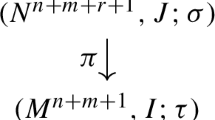Abstract
In this paper, necessary and sufficient conditions for null-controllability of a linear system under geometric constraints on the control are given, without the assumption that the origin is an equilibrium point of the system. The criterion for controllability uses the concept of a return condition on an interval which is introduced in the paper. This condition generalizes the existence of an equilibrium point.
Similar content being viewed by others
References
Nijmeijer, H., van der Schaft, A.: Nonlinear Dynamical Control Systems. Springer, New York (1990)
Sastry, S.: Nonlinear Systems. Analysis, Stability, and Control. Interdisciplinary Applied Mathematics, vol. 10. Springer, New York (1999)
Saperstone, S.H., Yorke, J.A.: Controllability of linear oscillatory systems using positive controls. SIAM J. Control Optim. 9, 253–262 (1971)
Brammer, R.F.: Controllability in linear autonomous systems with positive controllers. SIAM J. Control Optim. 10, 339–353 (1972)
Conti, R.: Return sets of a linear control process. J. Optim. Theory Appl. 41, 37–53 (1983)
Bianchini, R.M.: Local controllability, rest states and cyclic points SIAM J. Control Optim. 21, 714–720 (1983)
Korobov, V.I., Marinich, A.P., Podol’skii, E.N.: Controllability of linear autonomous systems with restrictions on the control. Differentsial’nye Uravneniya 11, 1967–1979 (1975) (English translation: Differ. Equ. 11, 1465–1474 (1976))
Korobov, V.I.: A Geometrical criterion for local controllability of dynamic systems with restriction on controls. Differentsial’nye Uravneniya 15, 1592–1599 (1979) (English translation: Differ. Equ. 15, 1136–1142 (1980))
Aubin, J.-P., Frankowska, H., Olech, C.: Controllability of convex processes. SIAM J. Control Optim. 24, 1192–1211 (1986)
Lee, E.B., Markus, L.: Foundations of Optimal Control Theory. Wiley, New York (1967)
Zverkin, A.M., Rozova, V.N.: The structure of a controllability region. Differentsial’nye Uravneniya 18, 234–239 (1982) (English translation: Differ. Equ. 18, 186–190 (1982))
Martheri, A.: On the 0-local controllability of a linear control system. J. Optim. Theory Appl. 66, 61–69 (1990)
Bianchini, R.M.: Complete controllability. J. Optim. Theory Appl. 50, 69–82 (1986)
Krein, M.G., Rutman, M.A.: Linear operators leaving invariant a cone in a Banach space. Uspehi Mat. Nauk 3, 3–95 (1948)
Korobov, V.I., Sklyar, G.M.: Methods for constructing of positional controls and an admissible maximum principle. Differentsial’nye Uravneniya 26, 1914–1924 (1990) (English translation: Differ. Equ. 26, 1422–1431 (1990))
Kun, L.A.: Connection between local and global controllability of a linear plant. Avtomatika i Telemehanika 10, 12–15 (1977) (English translation: Autom. Remote Control 38, 1437–1439 (1978))
Author information
Authors and Affiliations
Corresponding author
Additional information
Communicated by F.L. Chernousko
Rights and permissions
About this article
Cite this article
Korobov, V.I. Geometric Criterion for Controllability under Arbitrary Constraints on the Control. J Optim Theory Appl 134, 161–176 (2007). https://doi.org/10.1007/s10957-007-9212-2
Published:
Issue Date:
DOI: https://doi.org/10.1007/s10957-007-9212-2



